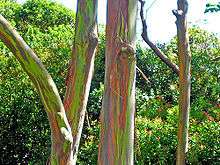Eucalyptus deglupta
| Rainbow gum | |
|---|---|
 | |
| View of multi-coloured bark | |
| Scientific classification | |
| Kingdom: | Plantae |
| Clade: | Angiosperms |
| Clade: | Eudicots |
| Clade: | Rosids |
| Order: | Myrtales |
| Family: | Myrtaceae |
| Genus: | Eucalyptus |
| Species: | E. deglupta |
| Binomial name | |
| Eucalyptus deglupta | |
Eucalyptus deglupta is a tall tree, commonly known as the rainbow eucalyptus[1], Mindanao gum, or rainbow gum.[2] It is native to Indonesia, Papua New Guinea, and the Philippines,[3] and is the only Eucalyptus species with a natural range that extends into the northern hemisphere. It is characterized by multi-colored bark featuring hues of blue, purple, orange and maroon. It thrives in rich, medium to wet soil in full sun and is intolerant of frost.[4]
Description
In its native habitat, E. deglupta grows up to 2 m (6 ft) wide and over 80 m (250 ft) tall.[5] Outside of its natural habitat, it will only grow up to 38 m (125 ft) tall.[4]
E. deglupta is also known as the Mindanao gum tree, named after the island of Mindanao in the Philippines of which the tree is native to. Gum trees are a group of eucalyptus trees that are characterized by their smooth bark that periodically sheds.[6] E. deglupta are commonly planted as ornamental trees in frost-free climates such as Hawaii, Southern California, Texas, and Louisiana.[7]

Reproduction
E. deglupta features evergreen foliage and flowers once a year. Flowering may occur within the 1st year but usually begins after 2 years and continues annually.[3] The tree produces white flowers with moderately wide leaves. The flower buds contain stamens and pistil and are usually pollinated via bee. After fertilization, the flower capsule becomes a woody fruit, known as a gum nut, which contains the seeds.[6]
Rainbow Bark
The unique multi-hued bark is the most distinctive feature of the tree. Patches of outer bark are shed annually at different times, showing a bright green inner bark. This then darkens and matures to give blue, purple, orange and then maroon tones. The previous season’s bark peels off in strips to reveal a brightly colored new bark below. The peeling process results in vertical streaks of red, orange, green, blue, and gray. The colours of the bark are not as intense outside the tree's native range.[8][9]
Uses
In the present day this tree is grown widely around the world in tree plantations, mainly for pulpwood used in making white paper. It is the dominant species used for pulpwood plantations in the Philippines.[10]
References
- ↑ "UFEI - SelecTree: A Tree Selection Guide". selectree.calpoly.edu. Retrieved 2018-04-29.
- ↑ "Rainbow Gums". Double Helix. CSIRO. Retrieved 8 August 2017.
- 1 2 "You are being redirected…". www.worldagroforestry.org. Retrieved 2018-04-29.
- 1 2 "Eucalyptus deglupta - Plant Finder". www.missouribotanicalgarden.org. Retrieved 2018-04-29.
- ↑ http://www.treehugger.com/natural-sciences/nature-blows-my-mind-rainbow-covered-eucalyptus-deglupta-trees.html
- 1 2 "Rainbow Eucalyptus: An Unusual Tree With a Multicoloured Trunk". Owlcation. Retrieved 2018-04-29.
- ↑ "Rainbow Eucalyptus Tree – Learn About Rainbow Eucalyptus Growing Conditions". www.gardeningknowhow.com. Retrieved 2018-04-29.
- ↑ In botanical gardens such as Fairchild Botanical Gardens in Florida the tree does show the intense color range as see in the tree's normal range. Garner, LariAnn. "Under the Rainbow" (pdf). Retrieved 2007-01-10.
- ↑ David Webster Lee (2007). Nature's palette: the science of plant color. University of Chicago Press. p. 228. ISBN 9780226471051. Retrieved 2011-04-22.
- ↑ "Notes on Eucalyptus" (PDF). National Resources Institute. Archived from the original (pdf) on 2007-09-27. Retrieved 2007-01-10.
External links
| Wikimedia Commons has media related to Eucalyptus deglupta. |
| Wikispecies has information related to Eucalyptus deglupta |